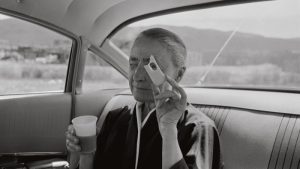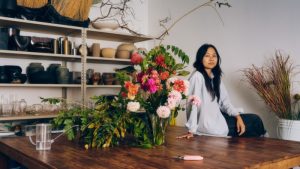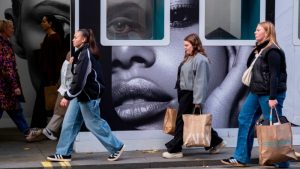The close-knit crew of Hawarden Castle
On a late September morning, the stone staircase leading from the Gothic front door into the heart of Hawarden Castle – the former seat of William Ewart Gladstone, four-time British prime minister – is a hubbub of excitable hounds, a tremendous number of walking boots and a collection of Liverpool FC scarves knotted around a couple of serious-looking busts. “Every time I go to the football I buy a new scarf,” says Charlie Gladstone, 8th baronet, entrepreneur, author, great-great grandson of the PM, father of six and an Anfield regular. “I bought an unlucky one on Saturday: Luis Díaz. A disaster.”

On the border of north Wales, less than 20 miles from Liverpool, Hawarden – an 18th-century mansion remodelled in the Gothic style, with the remains of its medieval keep standing high above the grounds – has for the past 15 years been the focus of this current iteration of Gladstones: Charlie and his wife Caroline, their six adult children (hence the great many walking boots), Jack, Xanthe, Tara, India, Felix and Kinvara, three grandchildren, and everyone’s dogs. Since the clan first moved in and got to work, in 2010, the estate has gone from indebted wreck to grand but welcoming family home. It’s also at the heart of a thriving network of creative businesses that employ almost 100 people and include a farm shop, bakery and café, a village pub, a campsite, a series of festivals and experiences, and luxury accommodation. This autumn, the family will add another string to its bow: Gladstone/Hellen, a new line of luxury clothing and homewares all made exclusively in Britain.


“It’s about being relevant. These estates are anachronistic,” says Charlie, in the columned “big sitting room”, where a Van Dyck portrait of an ancestor presides over a mix of old family pieces and tables by the contemporary British furniture makers Pinch. The estate’s panoply of interests gives Hawarden a very contrasting purpose and atmosphere to how it was when Charlie grew up there. “It’s hard to explain how different it is, how bad it was when we got here,” he says. “Not only did it look different, it was completely lifeless.”
Charlie’s parents, Sir Erskine William Gladstone, 7th Baronet of Fasque and Balfour, a teacher and Knight of the Garter, and his wife, Rosamund, were broadly overwhelmed by the estate. While preserving the historically important spaces, including the prime minister’s world-famous private library, the Temple of Peace, they retreated into just six rooms, dividing them, lowering ceilings and abandoning the top floor altogether. “My mother hated the house,” says Charlie. “I think my father felt very alone in it. It’s very hard if you’re not both into the project as a couple.”




In contrast, and from the off, Charlie and Caroline’s has been a creative partnership, forging a shared enthusiasm for art, music and design into a colourful, warm and witty signature style stamped across Hawarden and all their endeavours. The couple met in London in their early 20s, when Charlie – who had already inherited Hawarden and the Scottish estate Glen Dye – was in the music industry (he discovered The Charlatans and went on to sign They Might Be Giants). Unlike Sir William, who spent his time studying family history, Charlie, educated at Eton and Oxford according to family tradition, had always looked outward, thrilled by fashion, film and pop music, taking inspiration from his great-uncle Cecil Beaton.
“He used to come here a lot and we went to stay with him,” says Charlie. “He was amazing, and although he was only semi-interested in young people, he was a big influence on me. Living with the legacy of William Gladstone, who was very serious, industrious, academic, high church, austere, he legitimised my desire to be creative.” Caroline, a diplomat’s daughter who had grown up all over the world, was at that time a designer for Laura Ashley, working closely with Ashley herself. When they had Jack, their first child, they moved to Glen Dye, where they channelled their creativity into a mammoth renovation. “A totally derelict estate in a singularly beautiful location,” says Charlie. “We had two options. One was to say, ‘We can’t do it’, and the other was to use it as a blank canvas and look at it positively. It was brutal because we were very much in debt as an estate and as a family.”


While bringing Glen Dye back to life, they also produced five more baby Gladstones and founded and operated their first retail business, Pedlars. It morphed from clothing into a successful homewares brand, selling a vibrant mix of vintage and new furniture, tableware and prints, eventually with nine stores (one in Japan) including concessions in Selfridges. While Charlie has had regrets about the over-expansion, which eventually led to what he calls the “inauspicious end” of the 23-year-old business (it was partly sold in 2016 and now no longer operates), its lessons were lasting. “Pedlars taught us a great deal about the value of our own design, our own eye; just trusting our instinct about what was great product.”

It’s a talent inherited by the children, who have all gone on to work in creative industries and are now bringing their experience and skills back to Hawarden and its enterprises. “I think the biggest thing that we share is a fascination and obsession with art and other tactile, musical or visual things,” says Jack, a graphic designer. “And while our tastes may sometimes differ, the enthusiasm for discovering these things is always there.”
Tara Richards-Gladstone, who previously worked for a creative agency, is currently the most heavily involved in the family business. Based part-time in Hawarden, she is the director of The Good Life Society, the umbrella for holidays, festivals and other events on the estate. There are 10 rental properties at Glen Dye, and at Hawarden you can stay in the Beekeeper’s Hut, the Gardener’s House or the recently opened West End, a separate wing of the castle decorated in high Gladstone style with an eclectic abundance of art, books and bright textiles. Xanthe [Ross], a successful chef and supper-club host with almost 70,000 followers on Instagram, set up the estate’s bakery and continues to work part-time for the estate. And now Jack, 35, India, 33, and Kinvara, 27, are throwing their collective branding expertise into Gladstone/Hellen.
“When Dad told us about the project, we all sort of thought, ‘Not another one,’” says Jack. “But when he explained it further, you could tell this wasn’t just an impulse. Everything had already been meticulously thought out. There’s a genuine belief that we could make this work, and you can’t ignore that sort of passion and optimism.”


Gladstone/Hellen has been set up with Sarah Hellen, a fashion designer and expert in Welsh craft who grew up near Hawarden and has been working with the Gladstones for more than seven years. “The idea is a beautiful wardrobe you could wear here today or you could wear to go out to dinner in London tomorrow,” she says. They are starting with a capsule of clothing that includes chore-like tailored jackets for men and women made from cotton, corduroy and flannel woven at Dugdale Bros & Co in Huddersfield (from £549); shirts made in Blackburn (from £279); and knitwear spun in Peterhead in Scotland, including an authentic Fair Isle pattern – “the oldest, named North Star”, says Caroline, who is the colourist (there isn’t a colour across Hawarden or any Gladstone enterprise that she hasn’t created or chosen). Trousers will come next year. Hand-blocked and hemmed silk scarves are from a maker in Kent. Colourful printed scarves have “Let’s go country” emblazoned across them (£280). Next year it will be “Let’s go city”.




Homewares include exclusive blankets, throws and cushions in an orange St David’s cross pattern from Melin Tregwynt in Wales; Sheffield-made knives of stainless-steel and Scottish horn (£295); basketware from east Scotland and the Western Isles; and notebooks made out of English paper (£12). Limited-edition prints of linocuts by the artist Sam Scales portray an osprey, a lurcher, an oak. “You can’t get more British than that,” says Charlie.
The headquarters is a studio on the ground floor of the castle that will be open by appointment. Its entrance is marked in flamboyant style by a pair of giant gold painted wooden scissors, originally from a shop in 1920s Paris (it was found by Charlie, who has a vast network of vintage and salvage dealers). Inside, the space is packed with Gladstone inspirations such as baskets of apples, crates of vinyl records and axes – a family motif, since William Gladstone, a Liberal who considered himself a man of the people, was an avid tree-chopper; his collection of axes can be seen in the library. “Thousands of people used to come out to watch him,” says Caroline. “Before he took his shirt off the ladies were told to turn their heads.” The former prime minister’s reputation has suffered in recent years, following the exposure of his father John’s connection to slavery in Guyana. Last year, the family went to Guyana to formally apologise, an action that became front-page news. “We felt that William Gladstone was so famous and his father got the highest compensation for abolition,” says Charlie. “We wanted to address the past.”


Time now to address the future. “Everything at Gladstone/Hellen is so thoughtful and, having worked at some huge companies, I understand how rare that is,” says India, a fashion journalist, trained psychologist and now in-house copywriter, who has recently moved back to live on the estate with her husband and young family. “It’s about embracing British tradition through incredible pieces and products. We want to shout from the rooftops about how incredible the world of British manufacturing is.” The Gladstones’ next chapter begins.
gladstonehellen.co.uk
#closeknit #crew #Hawarden #Castle









